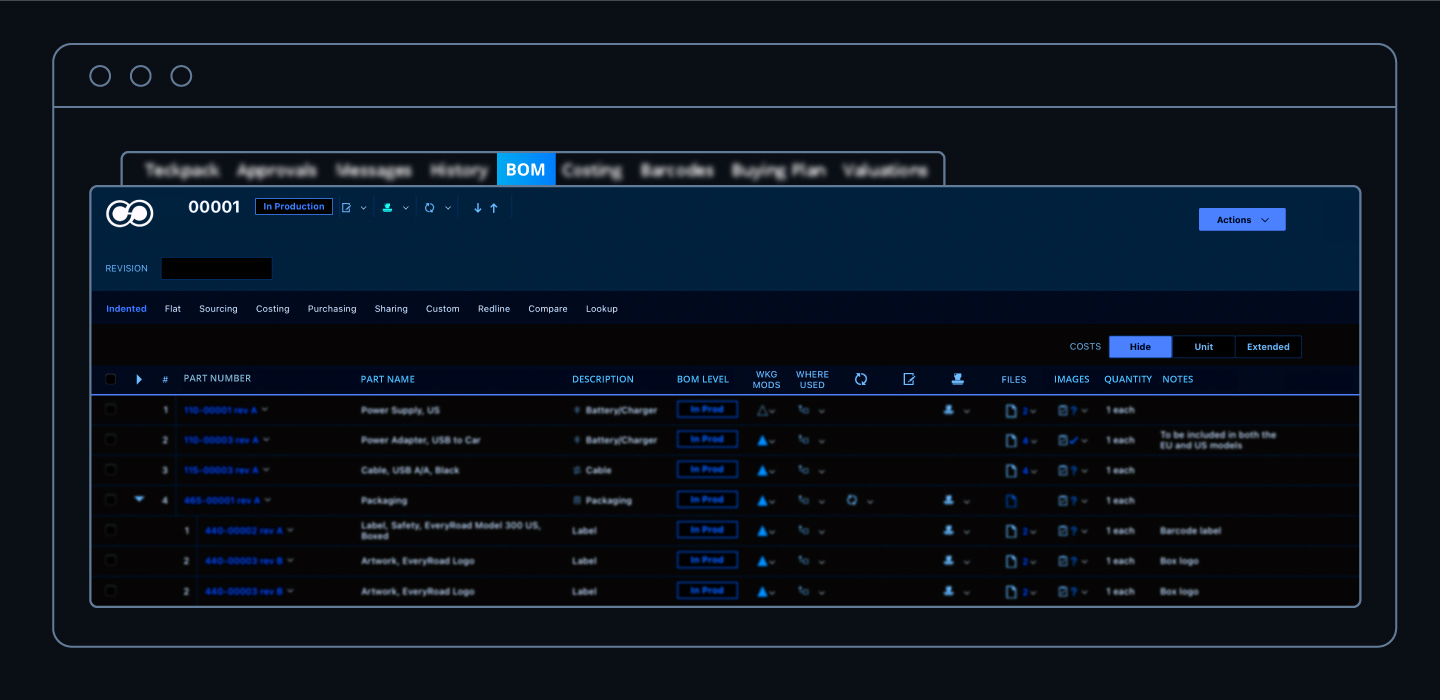What is a Bill of Materials (BOM) and Why You Need One?

What is a BOM (Bill of Materials)?
A Bill of Materials (BOM) is a list of raw materials that are required to produce and manufacture a product stored in a centralized source of truth. Multiple teams are required during product development, therefore, the bill of materials bridges the gap between design, product development manufacturing and distribution to cohesively collaborate. The BOM not only contains a detailed list of items, it also includes instructions on how to procure and use the items. This information can be stored in a spreadsheet, ERP or modern integrated systems like PLM to name a few.
Essentially a bill of materials is the blueprint for manufacturing a product correctly by pulling together all product information from concept to the deployment accurately, with up-to-date product data, enhancing visibility across the production process and effectively managing costs.
From apparel to packaged foods, cosmetics to electronics, any product that is manufactured from a variety of materials, components or ingredients, requires a BOM.
Once a product has been designed and developed, companies send the latest corresponding BOM to their manufacturing partners to have their products made. BOMs are used by brands to ensure their products are manufactured consistently, prevent errors and manage supply chains effectively and efficiently.
Whether a manufacturer is in Vietnam or China, the host company knows that their vendor partner will make their product the right way, every time.
Types of Bill of Materials (BOMs)
There are many different types of Bill of Materials. They can be single or multi-level and focused on different types of information. Some are unique to specific business sectors too.
Here’s some more detail about three of the more common types of BOM:
Sales Bill of Materials (SBOM)
A sales BOM lists the products and components required to develop a product as ordered by the customer. It’s built out from the original sales order and includes both the finished product and components, as they appear in the sales record.
Engineering Bill of Materials (EBOM)
An engineering BOM is the current production configuration that is developed while a product is being designed and it defines the finished product design. Often created by engineers in CAD software, it usually consists of a technical drawing of the product and includes the items, parts, components and subassemblies of the product.
Manufacturing Bill of Materials (MBOM)
A manufacturing BOM is used during production. It identifies the items and processes needed to produce a final product. It will include packaging and also accounts for waste and items consumed in the production process.
Information in the MBOM is typically shared with several systems, such as Enterprise Resource Planning (ERP) and Material Requirement Planning (MRP) systems.
How to Make a Bill of Materials
So what does a good BOM look like? What should be included? Remember it’s a list of materials and components plus instructions on what to do with them to make the final product. Here’s our list of the main elements that make up most BOMs. Don’t forget that while the Bill of Materials includes components, ingredients or materials, it doesn’t include the labor required.

Quantity: Indicates how much of each element will be used in the final product. For a single polo shirt, it might state three buttons and one pocket for example.
Unit of measurement: Shows in what unit of measure an element will be procured and/or used. Specifying the unit of measure helps ensure the right quantity is ordered.
BOM level: This is a unique reference number that shows where each element fits within the overall product. In our lasagna example, the main ingredients would be the pasta, the béchamel sauce and the meat sauce. Each of these would be a level that might then be broken down further. For example, the meat sauce might consist of minced beef, tomatoes, garlic and seasoning. Which could then be broken down further into sub-levels depending on the complexity, taste profile and any sustainability targets of the product.
Part number: Allocating a unique number to each element allows anyone involved in the production process to identify it quickly.
Part name: Similar to the above, giving each element a name allows it to be identified quickly.
Raw material: This allows the basics of the product to be identified. For example, how much beef, milk, cheese and tomatoes will be required to make a production run of 10,000 units of individually portioned lasagna?
Description: Unique to each element, this allows more detail to be added beyond the part name or number.
Notes: This section provides an opportunity to add any other essential information or detail the specifications that an ingredient, material or component must meet. For example, the lasagna meat may need to be 100% US beef.
Images: This allows images to be added that help the manufacturer understand what the final product must look like. Depending on the sector it can also contain detailed drawings and plans of more complex products.
Procurement method: Shows how the ingredient, element or component must be obtained. Helps to ensure traceability.
Why Should You Consider Using a BOM?
A good BOM powers efficient and accurate manufacturing. It allows businesses to identify and price all the elements and processes needed to make a product before production actually begins. This takes the risk out of production and ensures everything is in place to move forward.

Using a BOM reduces the likelihood of either shortages or overages of materials, ingredients or components. It helps to ensure the right ingredients, items or materials are available at the right time and in the right quantities, meaning that manufacturers remain within budget and on schedule.
Companies that work with contract manufacturers can also be confident the final product will meet their specifications. Plus a good BOM is also essential in building excellent vendor relationships. Mistakes cost time and money and business relationships are too valuable to risk by sending bad data to a vendor partner.
Using BOMs also allows smaller companies to easily meet vendor minimum order requirements while larger companies can use BOMs to share production volume around and prevent overloading their vendor partners.
BOMs also help companies achieve their sustainability goals. Using reverse BOMs can show how any waste from manufacturing products can be directed into the creation of new and profitable lines.
What is a Software Bill of Materials (SBOM)
According to the National Telecommunications and Information Administration (NTIA) a “Software Bill of Materials” (SBOM) is a nested inventory for software, a list of ingredients that make up software components.” Key information includes author name, component name, license information, version numbers, unique identifier and vendor name. SBOMs, primarily are used to identify components relationships with one another in a standardized format.
Today’s software packages often use BOM principles to manage a mixture of open source and bespoke commercial code to be able to share data across the supply chain to minimize the need for other tools, thus reducing cost, maintain security and compliance.
PLM and Bill of Materials
BOMs are such a crucial element across manufacturing and businesses especially when multiple products with hundreds of different elements are being produced. Gone are the days where Excel spreadsheets would suffice, therefore, next-generation tools such as Product Lifecycle Management (PLM) systems allow easy access to BOMs in real-time.
Incorporating BOMs into a PLM system such as Centric PLM allows businesses to manage product information in one centralized space.
BOM is one of the critical data sheets within Centric Software’s PLM system. Using the BOM module allows teams the ability to work in context, but also to be able to interact with other parts of the system, for example, if the user had a material and wanted to create a new color, there are actions to create a new color directly from the BOM instead of having to go somewhere else in the system to create a new material first.
Examples of BOM in Action
Making changes to the BOM in Excel for 30 to 50 different styles. Then, in a separate place, we were making changes to the measurements.
It’s true that a Bill of Materials is the starting point for the product, however, it’s definitely not the end. Using the BOM module within Centric PLM is such a powerful combination because it allows product ideation and development teams to instantly see the commercial impact of any tweaks or changes they make to the BOM. Enabling them to successfully meet market and consumer demand by developing profitable, traceable, compliant, safe, sustainable and innovative manufactured products.









Badlandsジャケットの仕様書は30ページにも及び、素材表には200以上のアイテムがあり、カラーリングも5種類あります。1,000種類ものそれぞれ異なる物事を管理しながら正確な生産工程が求められます。Centric PLMがなければ実現不可能でした。